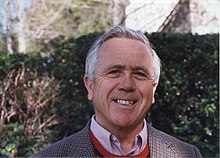Rodney Baxter
Rodney Baxter | |
|---|---|
 Baxter in 1999 | |
| Born | 8 February 1940 |
| Education | Bancroft's School |
| Alma mater | Trinity College, Cambridge (BA, MA) Australian National University (PhD) |
| Known for | Yang-Baxter equation Yang-Baxter operator |
| Scientific career | |
| Fields | Theoretical Physics |
| Institutions | Iraq Petroleum Company (1964-1965) Massachusetts Institute of Technology (1968-1970) Isaac Newton Institute, Cambridge (1992) Australian National University (1970-2002) |
Rodney James Baxter FRS FAA (born 8 February 1940 in London, United Kingdom) is an Australian physicist, specialising in statistical mechanics. He is well known for his work in exactly solved models, in particular vertex models such as the six-vertex model and eight-vertex model, and the chiral Potts model and hard hexagon model. A recurring theme in the solution of such models, the Yang–Baxter equation, also known as the "star–triangle relation", is named in his honour.
Biography
[edit]Baxter was educated at Bancroft's School and Trinity College, Cambridge (BA, MA), before relocating to the Australian National University in Canberra to complete his PhD. He was among the first doctoral graduates in theoretical physics from the ANU, graduating in 1964. Then, in 1964 and 1965, he worked for the Iraq Petroleum Company. He worked as an assistant professor at the Massachusetts Institute of Technology from 1968 until 1970, when he took up a position at the ANU, and served a term as the Head of the Department of Theoretical Physics in the Institute of Advanced Study, until he retired in 2002. He is currently the Emeritus Professor of Physics. In 1984, he was awarded a Doctor of Science by Cambridge. He is a Fellow of the Australian Academy of Science, Royal Society of London, and the Isaac Newton Institute, Cambridge, where he was Royal Society Research Professor in 1992. In 1980 he was awarded the Boltzmann Medal, the main recognition for research contribution concerning statistical mechanics. In 2006, he was awarded the Lars Onsager Prize "For his original and groundbreaking contributions to the field of exactly solved models in statistical mechanics, which continue to inspire profound developments in statistical physics and related fields".
Research
[edit]Baxter gained recognition in 1971 when he used the star-triangle relation to calculate the free energy of the eight-vertex model, and went on to similarly solve the hard hexagon model (1980) and the chiral Potts model in 1988. He also developed the corner transfer matrix method for calculating the order parameters of the eight-vertex and similar models. In 2005 he used the method of Michio Jimbo, Tetsuji Miwa and Nakayashiki to verify Albertini, McCoy, Perk and Tang's conjecture for the order parameter of the chiral Potts model.
His use of the Yang–Baxter equation led to the formulation and the study of representations of the quantum group by Vladimir Drinfeld in the 1980s, and quantum generalisations of affine algebras, and they are quasi-triangular Hopf algebras which yield solutions of the Yang–Baxter equation and provide insight into the properties of corresponding statistical models.
His book, Exactly solved models in statistical mechanics, has received over 4000 citations (according to Web of Science) in subsequent work in statistical mechanics and the study of quantum groups, and is used widely in teaching at universities.
Awards and honours
[edit]- Pawsey Medal, Australian Academy of Science, 1975
- Boltzmann Medal, IUPAP, 1980
- Thomas Ranken Lyle Medal, Australian Academy of Science, 1983
- Dannie Heineman Prize for Mathematical Physics, American Physical Society, 1987
- Harrie Massey Medal and Prize, Australian Institute of Physics / Institute of Physics (UK), 1994
- Fellow of the Australian Academy of Science, 1977
- Fellow of the Royal Society of London, 1982
- Centenary Medal, Australian Government, 2003
- Lars Onsager Prize, American Physical Society, 2006
- Royal Medal, 2013
- Henri Poincaré Prize, 2021
Publications
[edit]- Baxter, Rodney J. (1982), Exactly solved models in statistical mechanics (PDF), London: Academic Press Inc. [Harcourt Brace Jovanovich Publishers], ISBN 978-0-12-083180-7, MR 0690578, Zbl 0538.60093
References
[edit]- V. Chari and A.N. Pressley, A Guide to Quantum Groups Cambridge University Press, 1994
External links
[edit]- 2006 Onsager Prize, www.physorg.com
- History of theoretical physics at ANU
- Elected FAA 1977, science.org.au
- Elected FRS 1982, royalsociety.org
- Royal Medal 2013, www.austms.org.au
This biography of a living person contains unreferenced categories (Category:People educated at Bancroft's School, Category:Fellows of the Royal Society, Category:Fellows of the Australian Academy of Science and Category:Royal Medal winners). (February 2024) |
